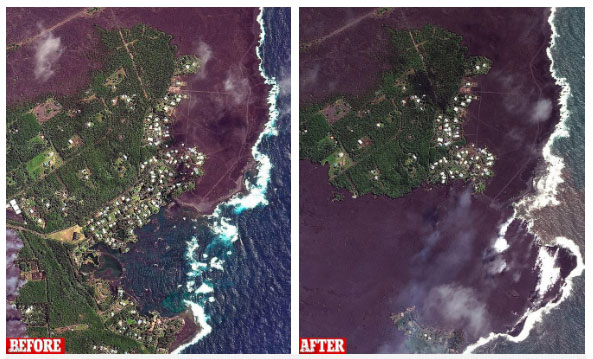Kilauea volcano has helped Hawaii
But is that good news? Will the land stay?
Since the outbreak of intense in early May 2018, Kilauea volcano has created one of the biggest disasters in the decade for the islanders of Hawaii. Up to now, 600 houses have been swallowed by lava, thousands of people have been evacuated, causing tens of millions of dollars in damage.
But in return, a recent statistic from the US Geological Survey (USGS) pointed out that lava from Kilauea helped the Hawaii territory to hatch more than 1.6 km. And more importantly, it never showed signs of stopping.
Specifically, experts said lava flows down Kapoho Bay are still very active, even more and more geological lava tubes opened.

Big Island has now expanded several kilometers.In return, many lands and rain forests were swallowed up.
"The lava continually flows into the sea in front of Kapoho Bay and the Vacationland resort area of the island. The island is expanding north" - quoted geologist Janet Babb at USGS.
What will the new land look like?
All of the swellings of Hawaii would naturally be owned by the local government and by the United States. However, this does not mean that this will be a habitable land in the near future.
Depending on the climate, rainfall and some natural factors, new plants can grow. However, it takes more time for the rain to clean up this area, so that the forest can grow, or become a suitable place for humans.
"How quickly plants can grow depends on the type of lava, and the amount of rainfall around the area" - Babb shared.
"There are a number of lava flows towards Kona (a densely populated area on Big Island, Hawaii). They have been flowing for a long time, much longer than eastern Hawaii, but very few plants grow back because rainfall in 2 different areas ".

This land is still considered unstable.
Jessica Ferracane, a spokeswoman at Hawaii National Park, agrees."Rain really makes a difference."
"The ferns will spring up first, always with the newly hatched lands."
However, this land is still considered unstable. After the lava is cooled and hardened, we will have a very difficult area to live in, because it contains all the sharp volcanic glass fragments.
"Most new lands on the sea are very unstable," Ferracane said.
The problem is that no one knows when the lava will stop flowing. Let the future answer.
- Hawaii: Kilauea volcano creates a dusty column of ashes of up to 9,000 meters
- Smoke and bright red lava erupted from the Hawaii crater
- Scary pictures in Hawaii crater
- Volcanic eruptions in Hawaii, lava can be seen from outer space
- He was afraid of the sky burning like hell because of the Hawaii volcano
- Lake blue water at the bottom of the most active volcano in Hawaii
- Why do so many people live near volcanoes, challenge death?
- Horrifying videos of volcanic eruptions in Hawaii
- The largest lake in Hawaii evaporated after a few hours: What terrible thing happened?
- Hawaii: A series of 'lava' hot lava flows into the ocean
- Fire river appeared in Hawaii
- Detecting a series of golden rays gleaming like human hair but no one dared to touch it for the following reason
 Is the magnetic North Pole shift dangerous to humanity?
Is the magnetic North Pole shift dangerous to humanity? Washington legalizes the recycling of human bodies into fertilizer
Washington legalizes the recycling of human bodies into fertilizer Lightning stone - the mysterious guest
Lightning stone - the mysterious guest Stunned by the mysterious sunset, strange appearance
Stunned by the mysterious sunset, strange appearance Life could exist on Jupiter's moon
Life could exist on Jupiter's moon  Red hot lava flowing on snow causes confusion
Red hot lava flowing on snow causes confusion  Mysterious people lived in lava tubes 7,000 years ago in Arabia
Mysterious people lived in lava tubes 7,000 years ago in Arabia  Robot captures 320,000m2 lava field under the sea
Robot captures 320,000m2 lava field under the sea  Scientists reproduce the lava explosion
Scientists reproduce the lava explosion  Discovered an unprecedented depth of volcanic lava
Discovered an unprecedented depth of volcanic lava 